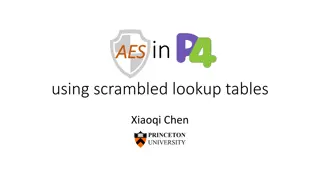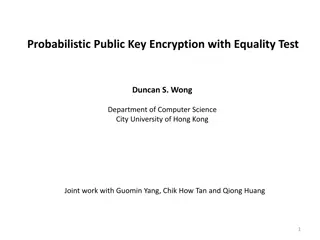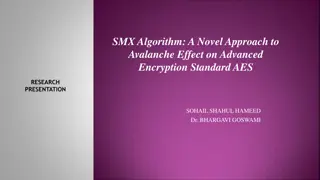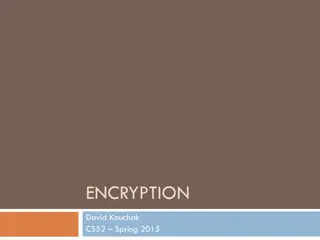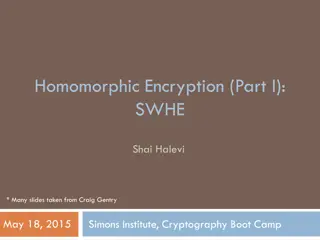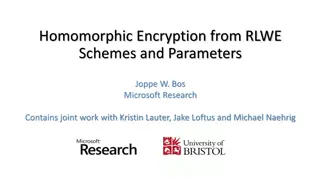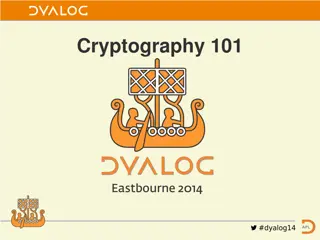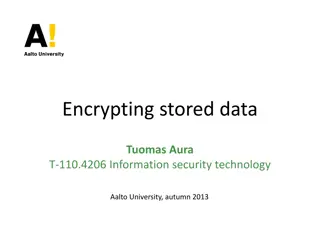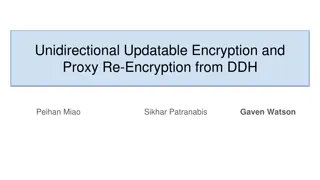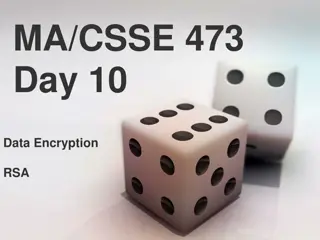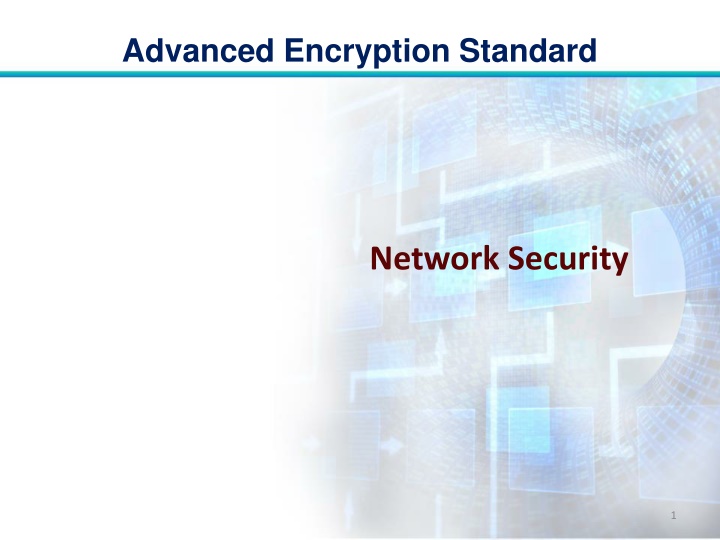
Advanced Encryption Standard for Network Security
Explore the Advanced Encryption Standard (AES) and its significance in network security. Learn about the objectives, drawbacks of 3DES, NIST's selection of Rijndael as AES algorithm, evaluation criteria, and more. Dive into AES's key length options and its adoption as a standard in 2001.
Download Presentation

Please find below an Image/Link to download the presentation.
The content on the website is provided AS IS for your information and personal use only. It may not be sold, licensed, or shared on other websites without obtaining consent from the author. If you encounter any issues during the download, it is possible that the publisher has removed the file from their server.
You are allowed to download the files provided on this website for personal or commercial use, subject to the condition that they are used lawfully. All files are the property of their respective owners.
The content on the website is provided AS IS for your information and personal use only. It may not be sold, licensed, or shared on other websites without obtaining consent from the author.
E N D
Presentation Transcript
Advanced Encryption Standard Network Security 1
Advanced Encryption Standard Objectives of the Topic After completing this topic, a student will be able to describe Advanced Encryption Standard. 2
Advanced Encryption Standard Figures and material in this topic have been adapted from Network Security Essentials: Applications and Standards , 2014, by William Stallings. 3
Advanced Encryption Standard The principal drawbacks of 3DES: 1.It has three times as many rounds as DEA and is correspondingly slower. 2.Both DEA and 3DES use a 64-bit block size. Its not a reasonable candidate for long term use. 4
Advanced Encryption Standard In 1997 NIST issued a call for proposals for a new AES: 1.Should have a security strength equal to or better than 3DES and significantly improved efficiency. 5
Advanced Encryption Standard 2. Must be a symmetric block cipher with a block length of 128 bits and support for key lengths of 128, 192, and 256 bits. 6
Advanced Encryption Standard 3. Evaluation criteria included security, computational efficiency, memory requirements, hardware and software suitability, and flexibility 7
Advanced Encryption Standard NIST selected Rijndael as the proposed AES algorithm Developers were two cryptographers from Belgium: Dr. Joan Daemen and Dr. Vincent Rijmen published as a final standard (FIPS PUB 197) in 2001. 8
Advanced Encryption Standard AES uses a block length of 128 bits and a key length that can be 128, 192, or 256 bits. For our discussion, we assume 128 bits in this topic. 9
Advanced Encryption Standard The input to the encryption and decryption algorithms is a single 128-bit block. In FIPS PUB 197, this block is depicted as a square matrix of bytes. 10
Advanced Encryption Standard The block is copied into the State array, which is modified at each stage of encryption or decryption. After the final stage, State is copied to an output matrix. 11
Advanced Encryption Standard Similarly, the 128-bit key is depicted as a square matrix of bytes. This key is then expanded into an array of key schedule words: Each word is four bytes and total key schedule is 44 words for 128-bit key. 12
Advanced Encryption Standard Ordering of bytes in a matrix is by column. First four bytes of a 128-bit plaintext input to the encryption cipher occupy the first column of the in matrix, the second four bytes occupy the second column, and so on. 13
Advanced Encryption Standard Similarly, the first four bytes of the expanded key, which form a word, occupy the first column of the w matrix. 14
Advanced Encryption Standard AES s Working: Four different stages are used, one of permutation and three of substitution 15
Advanced Encryption Standard Substitute bytes: Uses a table, referred to as an S-box, to perform a byte-by- byte substitution of the block. Shift rows: A simple permutation that is performed row by row. 16
Advanced Encryption Standard Mix columns: A substitution that alters each byte in a column as a function of all of the bytes in the column. Add round key: A simple bitwise XOR of the current block with a portion of the expanded key. 17
Advanced Encryption Standard Internal Details of a round. 19
Advanced Encryption Standard Some comments: AES structure is not a Feistel structure. For both encryption and decryption, the cipher begins with an Add Round Key stage, followed by nine rounds that each includes all four stages 21
Advanced Encryption Standard Each stage is easily reversible. The final round of both encryption and decryption consists of only three stages. The decryption algorithm is not identical to the encryption algorithm. 22
Advanced Encryption Standard The decryption algorithm makes use of the expanded key in reverse order. End 23


